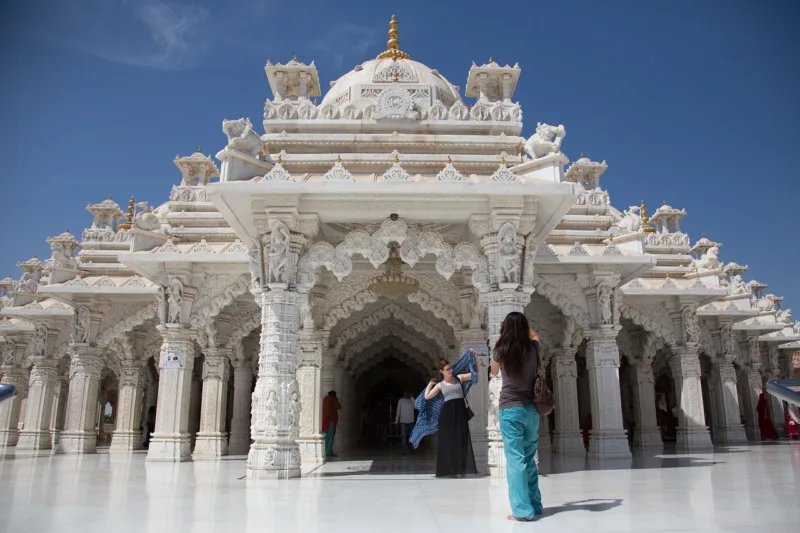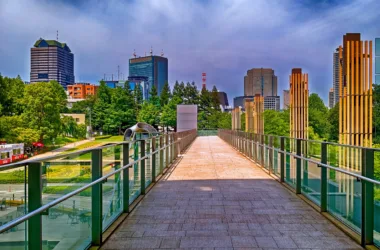India, a land of diverse cultures and rich traditions, is home to some of the most magnificent temples that showcase the country’s spiritual and architectural heritage. In this comprehensive guide, we take you on a virtual tour of 25 famous temples in India, each with its unique history, architectural splendor, and cultural significance.
1. Vaishno Devi Temple, Jammu & Kashmir
Nestled in the Trikuta Mountains, the Vaishno Devi Temple is a sacred pilgrimage site dedicated to Goddess Vaishno Devi. The trek to the temple through scenic landscapes is a spiritual journey cherished by millions.
2. Golden Temple, Amritsar, Punjab
The iconic Golden Temple, or Harmandir Sahib, is a symbol of Sikhism’s spiritual and architectural brilliance. Its golden façade, surrounded by the sacred Amrit Sarovar, exudes serenity.
3. Kedarnath Temple, Uttarakhand
Perched at an altitude of 3,583 meters, the Kedarnath Temple is one of the holiest shrines dedicated to Lord Shiva. The breathtaking backdrop of the Himalayas adds a mystical allure to this ancient site.
4. Brihadeeswarar Temple, Tamil Nadu
A UNESCO World Heritage Site, the Brihadeeswarar Temple in Thanjavur is an architectural marvel showcasing Dravidian grandeur. The towering vimana and intricate carvings mesmerize visitors.
5. Khajuraho Group of Monuments, Madhya Pradesh
The Khajuraho Temples are renowned for their exquisite erotic sculptures and intricate artistry. These UNESCO-listed temples provide a glimpse into the cultural and artistic finesse of ancient India.
6. Akshardham Temple, Delhi
A modern architectural masterpiece, the Akshardham Temple complex in Delhi combines spirituality with technology. The intricately carved mandir, exhibitions, and water show offer a holistic experience.
7. Jagannath Temple, Puri, Odisha
Dedicated to Lord Jagannath, the Jagannath Temple in Puri is famous for its annual Rath Yatra. The temple’s architecture, adorned with sculptures, reflects Odisha’s rich cultural heritage.
8. Badami Cave Temples, Karnataka
Carved out of sandstone cliffs, the Badami Cave Temples showcase ancient Chalukyan architecture. The four caves, adorned with exquisite sculptures, narrate tales from Hindu mythology.
9. Meenakshi Temple, Madurai, Tamil Nadu
The Meenakshi Temple is a masterpiece of Dravidian architecture. Its towering gopurams, intricately carved pillars, and the Hall of Thousand Pillars make it a must-visit for art and history enthusiasts.
10. Somnath Temple, Gujarat
Located on the coast of the Arabian Sea, the Somnath Temple is one of the twelve Jyotirlinga shrines dedicated to Lord Shiva. The temple’s resilience, rebuilt several times, symbolizes spiritual resilience.
11. Ranakpur Jain Temple, Rajasthan
Nestled in the Aravalli Range, the Ranakpur Jain Temple is an architectural marvel dedicated to Tirthankara Adinatha. The intricate marble carvings and 1,444 uniquely carved pillars leave visitors awe-inspired.
12. Kashi Vishwanath Temple, Varanasi, Uttar Pradesh
Situated on the banks of the Ganges, the Kashi Vishwanath Temple is one of the holiest shrines for Hindus. The spiritual aura, Ganga Aarti, and historical significance make it a pilgrimage of a lifetime.
13. Sri Ranganatha Swamy Temple, Srirangam, Tamil Nadu
The Sri Ranganatha Swamy Temple is the largest functioning temple complex in the world. Its impressive architecture, with seven concentric enclosures, reflects the Dravidian style.
14. Konark Sun Temple, Odisha
A UNESCO World Heritage Site, the Konark Sun Temple is a marvel of medieval architecture. Shaped like a chariot with intricate stone carvings, it pays homage to the Sun God.
15. Lingaraja Temple, Bhubaneswar, Odisha
Dedicated to Lord Shiva, the Lingaraja Temple is a significant pilgrimage site in Bhubaneswar. The temple’s towering spire and sacred pond add to the spiritual ambiance.
16. Amarnath Cave Temple, Jammu & Kashmir
Perched at an altitude of 3,888 meters, the Amarnath Cave Temple is dedicated to Lord Shiva. The annual Amarnath Yatra attracts devotees seeking the divine presence in the natural ice lingam.
17. Chennakesava Temple, Karnataka
Built by the Hoysala Empire, the Chennakesava Temple in Belur is a masterpiece of Hoysala architecture. The intricate sculptures and detailed carvings tell stories of devotion and artistry.
18. Rameswaram Ramanathaswamy Temple, Tamil Nadu
The Ramanathaswamy Temple, located on Rameswaram Island, is one of the twelve Jyotirlinga shrines. The temple’s grand corridors and sacred tanks add to the spiritual allure.
19. Dwarkadhish Temple, Gujarat
Dedicated to Lord Krishna, the Dwarkadhish Temple in Dwarka is a significant pilgrimage site. The temple’s architecture and its association with Hindu mythology make it a revered destination.
20. Sanchi Stupa, Madhya Pradesh
A UNESCO World Heritage Site, the Sanchi Stupa is a symbol of Buddhist art and architecture. The ancient stupas, gateways, and intricate carvings narrate the life of Lord Buddha.
21. Kailashnath Temple, Ellora, Maharashtra
Carved out of a single rock, the Kailashnath Temple in Ellora is dedicated to Lord Shiva. The intricate carvings and the sheer scale of the temple showcase ancient craftsmanship.
22. Badrinath Temple, Uttarakhand
Situated on the banks of the Alaknanda River, the Badrinath Temple is one of the Char Dham pilgrimage sites. The snow-capped peaks and the spiritual ambiance make it a sacred retreat.
23. Dilwara Temples, Mount Abu, Rajasthan
Renowned for their stunning marble architecture, the Dilwara Temples in Mount Abu are dedicated to Jain Tirthankaras. The intricate marble carvings and celestial motifs make them architectural gems.
24. Jaisalmer Jain Temples, Rajasthan
The Jaisalmer Jain Temples are architectural marvels in the heart of the Thar Desert. Intricate carvings, yellow sandstone architecture, and a spiritual ambiance make them a must-visit.
25. Hampi Virupaksha Temple, Karnataka
The Virupaksha Temple in Hampi, a UNESCO World Heritage Site, is dedicated to Lord Shiva. The temple’s historic significance, intricate architecture, and the annual chariot festival attract devotees and history enthusiasts alike.
In conclusion, exploring the 25 famous temples in India is a journey through the heart of the country’s spiritual and cultural tapestry. Each temple tells a unique story, reflecting the diversity and richness of India’s heritage.
Similar Articles
- Exploring the Sacred Journey from Lucknow to Kailash Mansarovar
- GITA MANDIR Dwarka
- Geger Temple, Nusa Dua
Frequently Asked Questions (FAQs) About Temples in India
1. What makes Indian temples unique?
Indian temples are unique for their diverse architectural styles, intricate carvings, and spiritual significance. Each temple reflects the rich cultural heritage and traditions of different regions in India.
2. How many temples are there in India?
It’s challenging to provide an exact number, as India is home to countless temples. Some estimates suggest there are over two million temples in the country, ranging from small local shrines to grand, iconic structures.
3. What is the significance of temple rituals in India?
Temple rituals in India hold immense cultural and spiritual importance. They often involve prayers, hymns, and offerings to the deity, creating a sacred atmosphere for devotees to connect with the divine.
4. Can non-Hindus visit Indian temples?
Many Indian temples welcome visitors of all faiths. However, it’s essential to respect the temple’s rules and traditions. Some temples may have specific restrictions or guidelines for non-Hindu visitors.
5. What are the major pilgrimage routes in India?
India boasts several pilgrimage routes, each with its unique significance. Some of the prominent ones include the Char Dham Yatra, the Twelve Jyotirlinga pilgrimage, and the Amarnath Yatra. These routes attract millions of devotees annually.
6. Are there any famous temple festivals in India?
Yes, India celebrates numerous temple festivals throughout the year. The Rath Yatra at the Jagannath Temple in Puri, Navaratri celebrations at various Durga temples, and the Kumbh Mela are some of the most famous and grand festivals.
7. How do I dress when visiting an Indian temple?
When visiting Indian temples, it’s advisable to dress modestly as a sign of respect. Women often wear traditional attire like sarees or salwar kameez, while men opt for traditional outfits like dhoti or kurta.
8. Are photography and videography allowed in Indian temples?
Rules regarding photography and videography vary from temple to temple. While some temples permit it, others may have restrictions, especially in inner sanctums. It’s essential to check and respect the rules of the specific temple you’re visiting.
9. What is the significance of prasadam in Indian temples?
Prasadam, the blessed food offered to deities, is considered sacred in Indian temples. Devotees receive prasadam as a divine blessing, and it is believed to carry the deity’s grace. It’s customary to accept prasadam with reverence.
10. How can I contribute to temple maintenance and charity?
Many temples have donation boxes or online platforms for devotees to contribute to temple maintenance and charitable activities. Some temples also run social welfare programs, and donations support these initiatives.
Exploring the temples of India is a journey into the heart of the country’s spirituality and cultural richness. Each temple has its own story to tell, adding to the tapestry of India’s diverse heritage.









